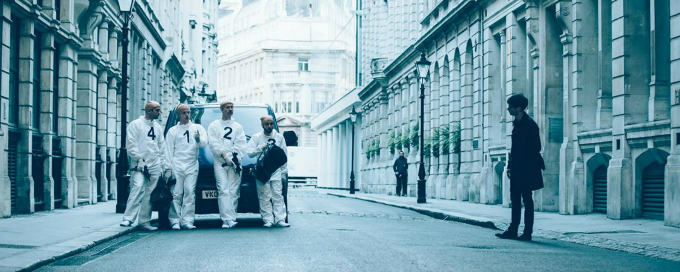
I haven’t read the Tom McCarthy novel that is the source for Omer Fast’s film, but it’s a credit to the film – and perhaps the writer – that its striking visual aesthetic and the rhythm and pace of the editing makes it difficult to imagine the story being told in any other way that might make sense of its main character’s disjointed mental processes. Even then it is not always easy to follow what is going on, but if you’re looking for an intelligent and intriguing film in the style of Christopher Nolan or Jonathan Glazer, one that functions as a complex flashback thriller and has deeper considerations on the nature of human memory and time, Remainder fares very well indeed.
There are no obvious clues where the film is coming from or where it is going to from the enigmatic opening scene that sets off (or leads up to? – it’s that kind of mobius strip film) the unusual events that follow. We see Tom leaving a building in the London business district, anxiously hurrying away with a suitcase to get a taxi with a woman folowing behind him. Just as he determinedly attempts to leave the scene, the building behind him seems to disintegrate and a heavy object lands on his head, knocking him to the ground, leaving him unconscious and seriously injured.
When he does recover, defying medical expectations, Tom (Tom Sturridge) inevitably doesn’t remember too much about what has happened or what has led up to the accident. He is however haunted by compelling memories and images that on the surface seem to have nothing to do with the incident in question. His suspicions are roused however by the behaviour of his friend Greg (Ed Speleers) and the false attentions he receives from Catherine (Cush Jumbo). Tom even seems to experience something like dèja-vu that allows him to anticipate what they are going to say next, and even know things before they happen. Two thugs also seem very interested in tracking Tom down and wrapping up any loose ends that might unravel should Tom recover his memories.
What is ‘reality’ anyway?
It’s the strange visions of buried memories however that start to obsess Tom, seeming to hold a clue or perhaps the key to working out what has happened. Having settled out of court for damages to the tune of eight and a half million pounds, Tom is in a position to explore unusual ways of making these visions a reality. Gathering a team of actors and building increasingly elaborate sets, Tom works on refining the resurfacing memories and images down to the last detail. But how far does he want to go to make the memories real, and what if they become more real than the reality? What is ‘reality’ anyway?
Despite the implications of such philosophical musing, and despite the apparent flirtation with the nature of filmmaking as an attempt to recreate reality, Remainder thankfully never gets bogged down in academic navel-gazing pretension. That doesn’t mean that it makes things easy to follow either, as the viewer, undoubtedly much to their confusion, is left to piece together this bewildering situation from the obsessive behaviour and unreliable perspective of Tom’s submerged half-memories. The fact that there is an intriguing mystery-thriller element behind it certainly helps keep the viewer’s curiosity piqued, and while answers are certainly revealed in a very surprising conclusion, they raise and leave other unanswered questions about the nature of time and memory that are even more intriguing.
httpvh://youtu.be/TJBXN9iFiVg

